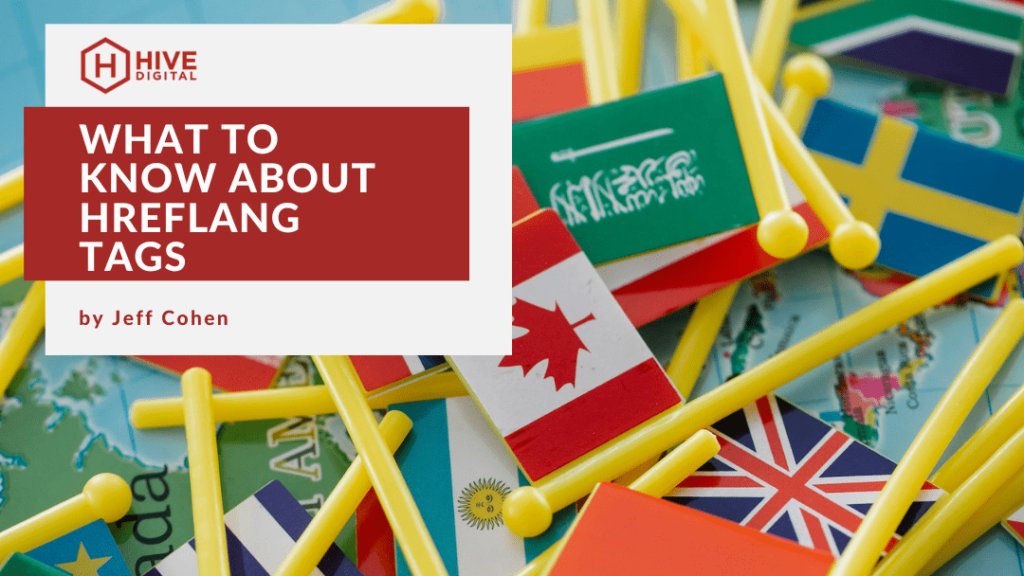What to Know About Hreflang Tags
When a website has multiple language or regional versions of a page, an hreflang tag can help a search engine crawler understand the relationship between those pages and show the appropriate language or regional version to users. Hreflang tags are simply a standard HTML attribute that can be used to let search engines know that your site has an alternate language or regional URL version of a webpage that should be displayed to users searching in specific languages or regions.
Hreflang tags are particularly important for international businesses with multilingual or multiregional websites, as they can help ensure that users are directed to the page that matches their language and location.
Hreflang tags are added to the HTML code of a webpage using the “rel” and “hreflang” attributes, and they typically look like this:
- <link rel=”alternate” hreflang=”es” href=”https://example.com/es/page.html”>
This example hreflang tag indicates that the page at the URL “https://example.com/es/page.html” is an alternate version of the current page, intended for users who speak Spanish (“es”).
Why should I use hreflang tags?
Ultimately, using hreflang tags can help to provide better results for your target audience. But first you need that audience to find your site, and search engines like hreflang tags because they help them to find the alternate language pages and regional targeting of your website.
For example, when Google understands the language and regional targeting of a website’s content, it can better match that content with users’ search queries and intent. This can improve the relevance and quality of search results.
In addition, implementing hreflang tags can help with other key SEO objectives such as…
Avoiding potentially duplicate content
Hreflang tags help to reduce the likelihood of duplicate content issues, which can negatively impact search engine rankings. By telling Google which language and regional versions of a page are unique and which are duplicates, hreflang tags can help to prevent confusion and ensure that the most relevant and authoritative version of a page is displayed in search results.
It gives your visitors a better user experience
When users search for content in their preferred language or region, they are more likely to click on and engage with websites that are relevant to their needs. By using hreflang tags, you can help ensure that users are directed to the most appropriate version of your website for them, which can improve their user experience, satisfaction, and ultimately lead to a better chance at conversion.
Should I use hreflang tags if I only market to an audience in one country?
If your website is intended for an audience in one country and you do not have multiple language versions or regional variations of your pages, then it may not be necessary to use hreflang tags. Hreflang tags are primarily used to indicate to search engines which language and regional versions of a page to serve to users in different locations or with different language preferences. If you only have one version of your website and it is targeted to a specific country, then search engines will likely automatically associate your website with that country and display it to users accordingly.
However, if you do have multiple language or regional versions of your website, even if you only market to an audience in one country, it can still be beneficial to use hreflang tags to help search engines understand the intended audience and avoid any potential confusion or duplicate content issues.
Is it hard to properly set up hreflang tags?
While setting up hreflang tags may require some technical knowledge, it is not necessarily difficult if you take time to plan ahead, follow best practices, and use the correct format and attributes. If you’re not comfortable setting up hreflang tags yourself, you may want to consider working with a developer or SEO professional who has experience with implementing these types of attribute tags.
Here are a few basic steps to follow to ensure that you set up hreflang tags correctly:
- Determine which pages on your website need hreflang tags: You should only use hreflang tags on pages that have different language or regional versions. For example, if you have a page that is available in English and Spanish, you should use hreflang tags on that page to signal to search engines that there are two versions of the page that target different languages.
- Identify the correct hreflang attribute: Hreflang tags use an attribute to identify the language and regional targeting of a page. The most common hreflang attributes are language-only (for example, “en” for English) and language-region (for example, “en-us” for English targeted to users in the United States). Make sure to choose the correct attribute based on the language and region of the page.
- Implement the hreflang tags: Hreflang tags can be implemented in several ways, including in the HTML head section of the page or in an XML sitemap. Make sure to use the correct format for the hreflang tag based on where you are implementing it.
- Verify that the hreflang tags are working correctly: Once you have implemented the hreflang tags, use Google Search Console or another tool to verify that they are working correctly. This can help you to identify any errors or issues that need to be corrected.
It’s important to note that if you make a mistake in your hreflang tag setup, it can potentially cause problems with how search engines crawl and index your website. Here are some common mistakes to avoid when implementing hreflang tags:
- Using incorrect or inconsistent language or region codes: Hreflang tags use language and region codes to identify the target language and region of a page. Make sure to use the correct codes for the language and region you are targeting, and ensure that you use the same codes consistently across all pages with hreflang tags.
- Using incorrect or incomplete URLs: Make sure to use the correct URL for each page in your hreflang tag, including any variations for different languages or regions. Check that the URLs are complete and include the protocol (http or https) and domain name.
- Incorrect placement or syntax: Hreflang tags should be placed in the head section of the HTML of each page, and the syntax should be correct. Make sure to use the correct hreflang attribute and that the syntax is correct for the placement you are using (HTML or XML sitemap).
If you do make a mistake in your hreflang tag, it is important to identify and correct the issue as soon as possible. You can use Google Search Console or other SEO tools to check for errors or warnings related to your hreflang tags.
What is the difference between HTML Lang and hreflang?
HTML lang and hreflang are two different attributes that serve different purposes:
- HTML lang: The HTML lang attribute is used to indicate the language of the content on a web page. This attribute is included in the HTML code of the page and is typically used for accessibility purposes, such as ensuring that screen readers can accurately read the content aloud in the appropriate language.
- For example, the following HTML code indicates that the content on the page is in English: <html lang=”en”>
- hreflang: The hreflang attribute, on the other hand, is used to indicate to search engines which language and/or regional version of a page to serve to users based on their language and location preferences. This attribute is included in the link tag of the page and is typically used for international SEO purposes.
- For example, the following hreflang tag indicates that the page is an alternate version of the English language page with the URL “https://www.example.com/en/page1.html“: <link rel=”alternate” hreflang=”en” href=”https://www.example.com/en/page1.html“>
Hreflang tags work more like a canonical tag, providing the search engine crawlers with information about an alternate version of the page that they should show when certain criteria are met.
Is it time for you to set up hreflang tags?
Overall, using hreflang tags is an important SEO best practice for any website with multi-language content or regional page versions. When you provide clear signals to search engines about your website’s language and regional targeting, you can improve your website’s visibility, relevance, and user experience.
Ultimately, the decision to use hreflang tags depends on the specific needs and goals of your website. If you’re unsure whether hreflang tags are necessary for your website, you may want to consult with a digital marketing specialist and put together an assessment and plan for implementing international SEO best practices.










